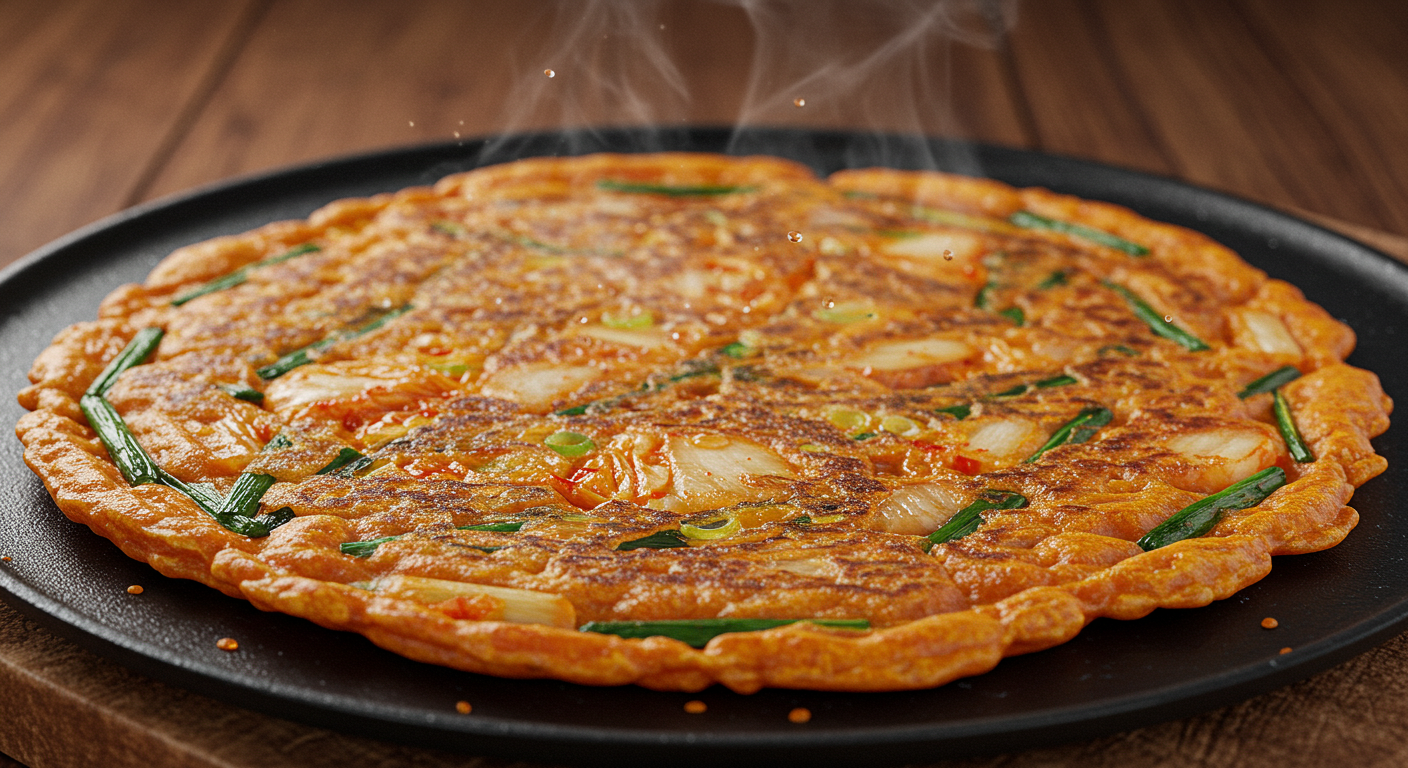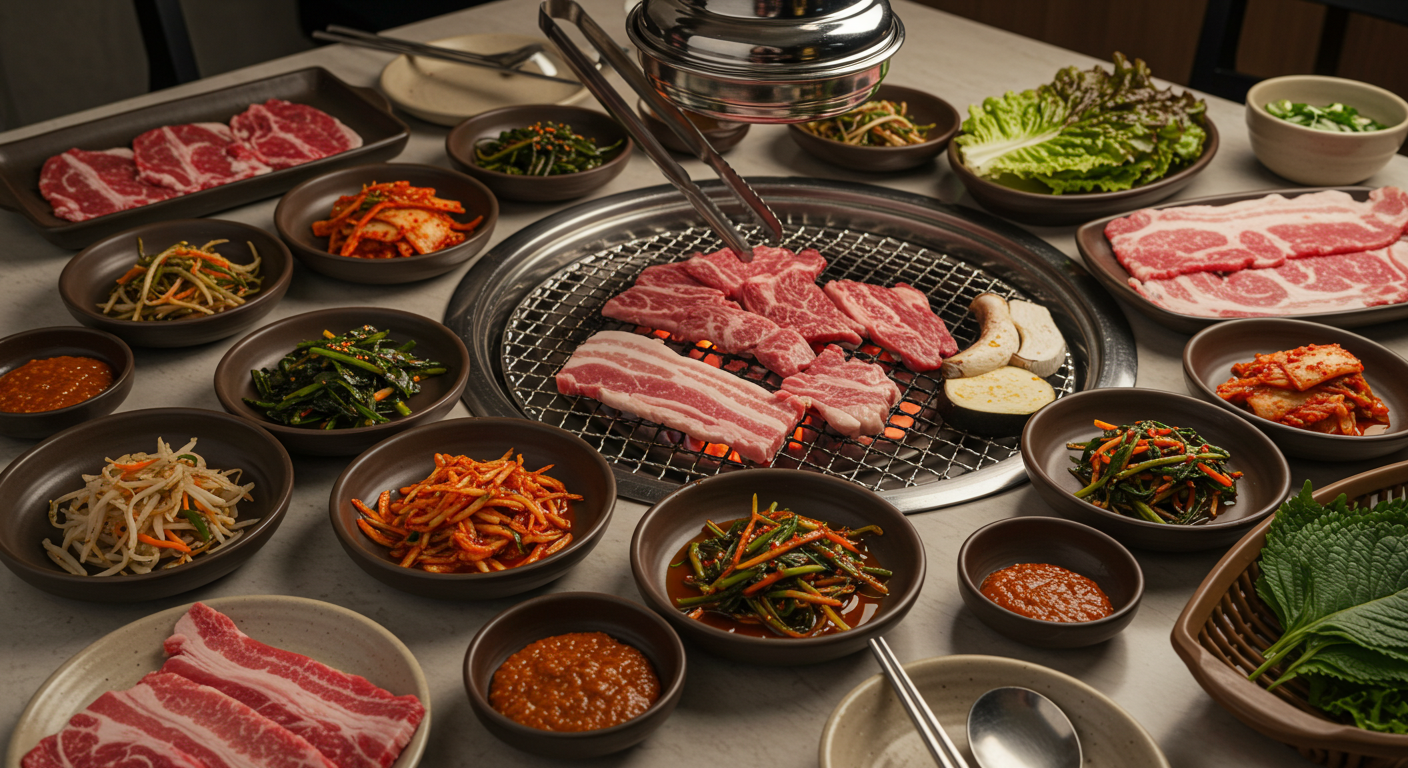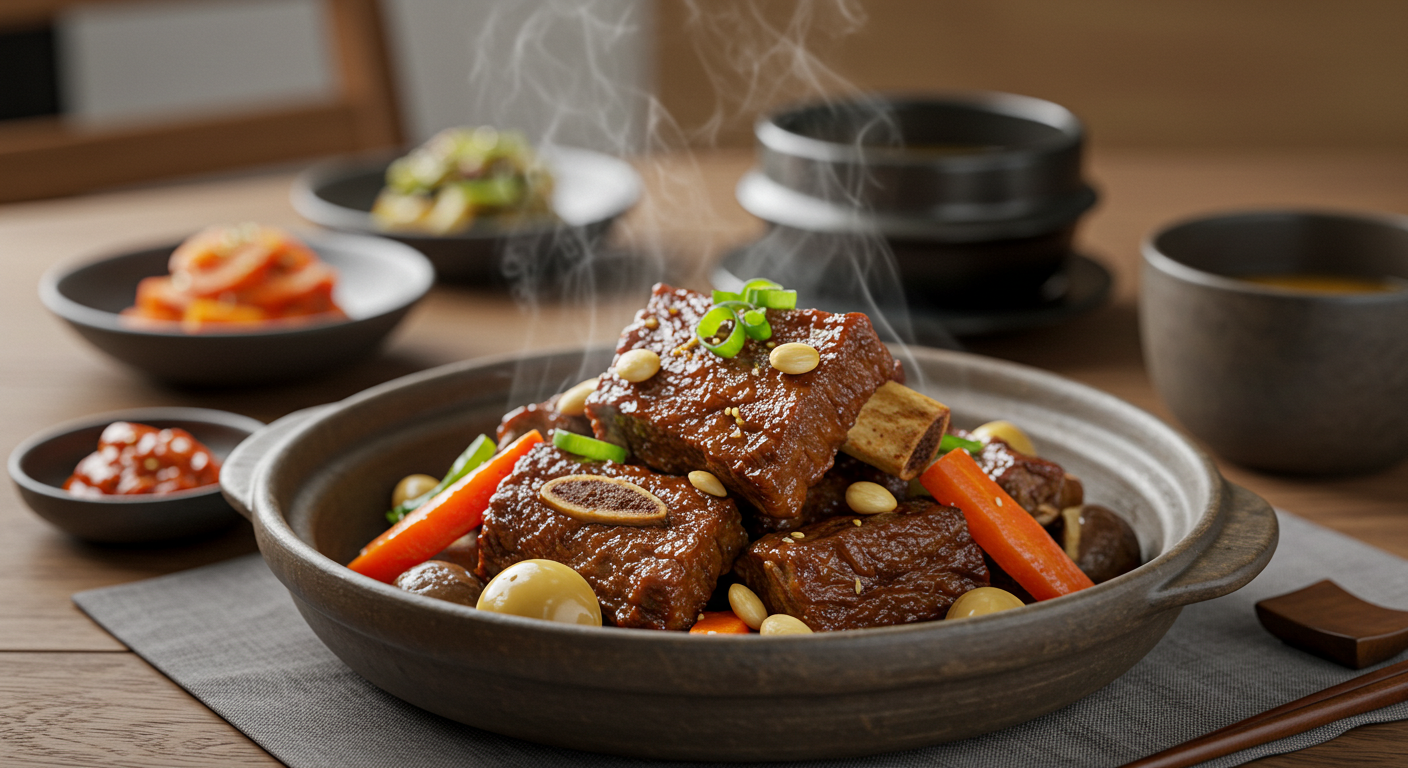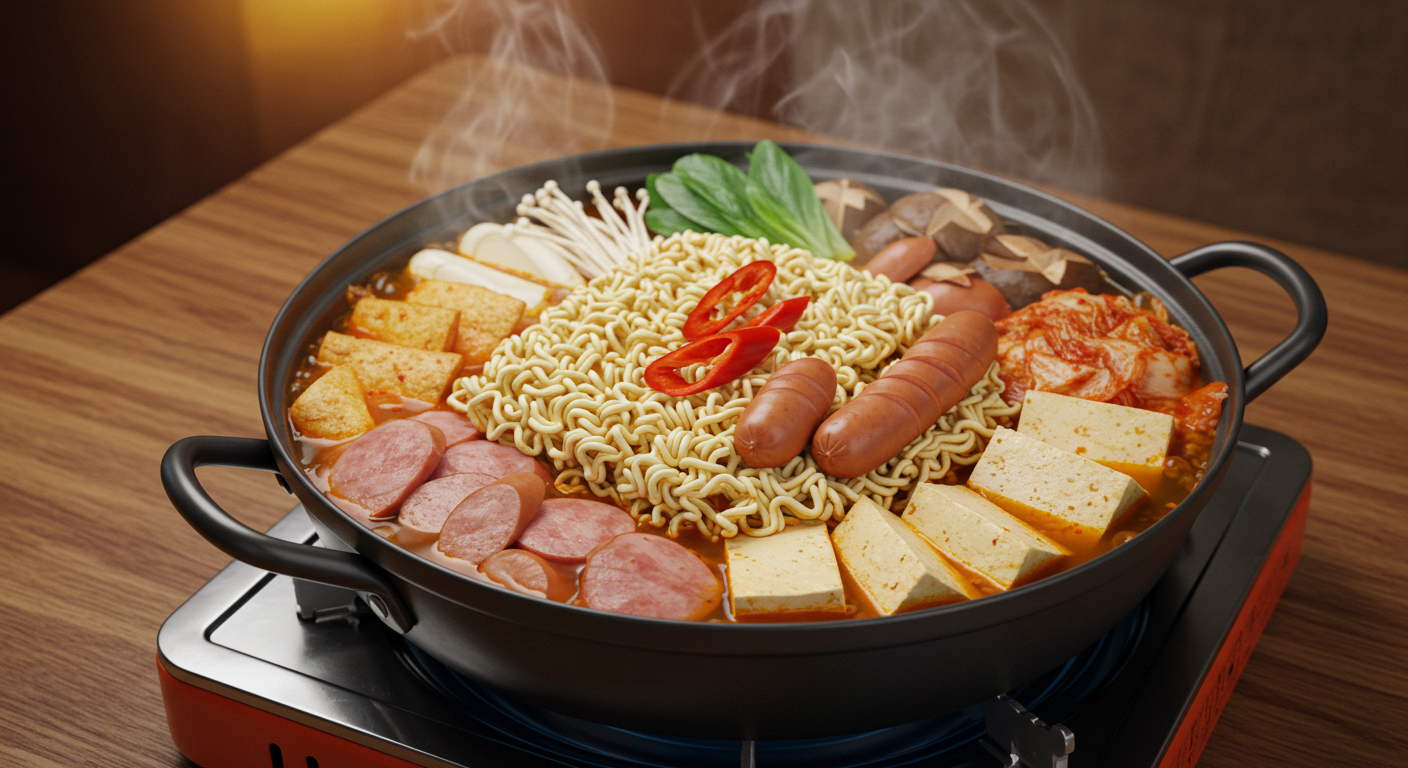
Curious about Budae Jjigae, Korea’s Unique Spicy Stew? Discover its History and Recipe! Born from the hardships of the Korean War, Budae Jjigae has now become a beloved K-Food icon, captivating palates worldwide. In this post, we’ll explore its special story and reveal how you can easily make it at home!
Hello everyone! Have you ever heard of a Korean dish called ‘Budae Jjigae’? 🥘 Perhaps it’s your first time, or maybe you’ve seen it in Korean dramas or movies. Honestly, it might look a bit surprising at first glance – a pot full of ingredients like ham, sausages, and ramen noodles. But once you taste it, you’ll be absolutely amazed by its spicy and savory flavor!
When I first tried Budae Jjigae, I thought, “What kind of combination is this?” But the moment I took a spoonful, I exclaimed, “Wow, this is truly delicious!” It’s a very familiar and beloved dish among Koreans, but it actually carries a somewhat sad history and story. So today, I’ll tell you how Budae Jjigae came to be, and I’ll share an easy and delicious recipe for you to make at home. Just trust me and follow along! 😊
What is Budae Jjigae? 🤔
Budae Jjigae is one of Korea’s representative stews. But the name is quite unique, isn’t it? Here, ‘Budae’ (部隊) means military unit, and ‘Jjigae’ refers to a stew or soup dish. As the name suggests, it has a history related to the military.
It’s a dish made by boiling various ingredients like ham, sausages, baked beans, tofu, kimchi, and vegetables in a spicy gochujang-based broth. Adding ramen noodles at the end is a special treat! It’s spicy yet savory, and the variety of ingredients makes it very satisfying to chew.
A Taste Born from Painful History: The Origin of Budae Jjigae 📜
To talk about the history of Budae Jjigae, we need to go back to the Korean War (1950-1953). During that time, everything was scarce due to the war, and it was especially difficult to get protein. That’s when processed foods like ham and sausages from U.S. military bases became precious provisions for Koreans.
People couldn’t bear to waste these valuable ingredients, so they started boiling them together with traditional Korean ingredients like kimchi and gochujang (Korean chili paste). This is how Budae Jjigae originated. Initially, it was also called ‘Johnson Tang’, supposedly named after a U.S. military officer or General Johnson, the commander of the U.S. Forces in Korea at the time. It’s a dish that shows the wisdom of Koreans who created a new food amidst the pain of war and difficult lives.
💡 Good to know!
Budae Jjigae is more than just a delicious dish; it’s also a symbolic food that carries the painful history of Korea. That’s why it holds an even more special meaning for Koreans.
If you’re interested in learning more about Korean history, you can visit The National Museum of Korea (external link). Or, check out this article on Korea.net about Budae Jjigae (external link).
Making Budae Jjigae at Home: It’s Not Hard! 🧑🍳
Now, it’s time for you to make Budae Jjigae yourself! Don’t worry, thinking “It looks difficult.” It’s actually much easier and simpler than you might think. Many of the ingredients needed are also easily available worldwide these days.
Ingredients (Serves 2-3) 📝
- Ham (Spam or canned ham): 200g
- Sausages (hot dog sausages or Vienna sausages): 100g
- Kimchi: 1 cup (approx. 150g, aged kimchi is even better!)
- Tofu: 1/2 block (approx. 150g)
- Onion: 1/2
- Green onion (scallion): 1 stalk
- Mushrooms (shiitake, oyster mushrooms, etc.): a small amount
- Sliced cheese: 1-2 slices (optional)
- Ramen noodles: 1 pack
- Water or broth: 800ml ~ 1L
Seasoning Ingredients 🌶️
- Gochujang (Korean chili paste): 2 tablespoons
- Gochugaru (Korean chili powder): 2 tablespoons (adjust for spice level)
- Soy sauce: 1 tablespoon
- Minced garlic: 1.5 tablespoons
- Sugar: 1/2 tablespoon
- Black pepper: a pinch
Cooking Instructions 👨🍳
- Prepare Ingredients: Slice ham and sausages into bite-sized pieces. Slice the onion thinly and the green onion diagonally. Cut tofu and mushrooms into appropriate sizes. Slice kimchi lengthwise.
- Make the Seasoning Paste: Put all the seasoning ingredients into a bowl and mix well to create the seasoning paste.
- Arrange Ingredients Neatly: In a wide pot or hot pot, spread the sliced kimchi on the bottom. Arrange the ham, sausages, tofu, onion, mushrooms, and green onion neatly on top, arranging by color. Place the prepared seasoning paste in the center.
- Add Liquid: Carefully pour water or broth into the pot. (Enough to half-submerge the ingredients is fine!)
- Boil and Simmer: Bring to a boil over high heat, then reduce to medium heat and simmer for another 5-7 minutes until the ingredients are cooked through and the broth is flavorful.
- Add Ramen and Cheese: Finally, add the ramen noodles and sliced cheese, and cook until the ramen is done. The melted cheese will add a richer and smoother taste!
- Enjoy Deliciously! It’s best served hot with a bowl of rice! 😊
⚠️ Caution!
If your kimchi is very sour or the seasoning paste is too much, the stew might become too salty. Adjust the amount of broth or reduce the kimchi. If you’re not used to spicy food, reducing the amount of gochugaru is a good option.
💡
Budae Jjigae Key Summary!
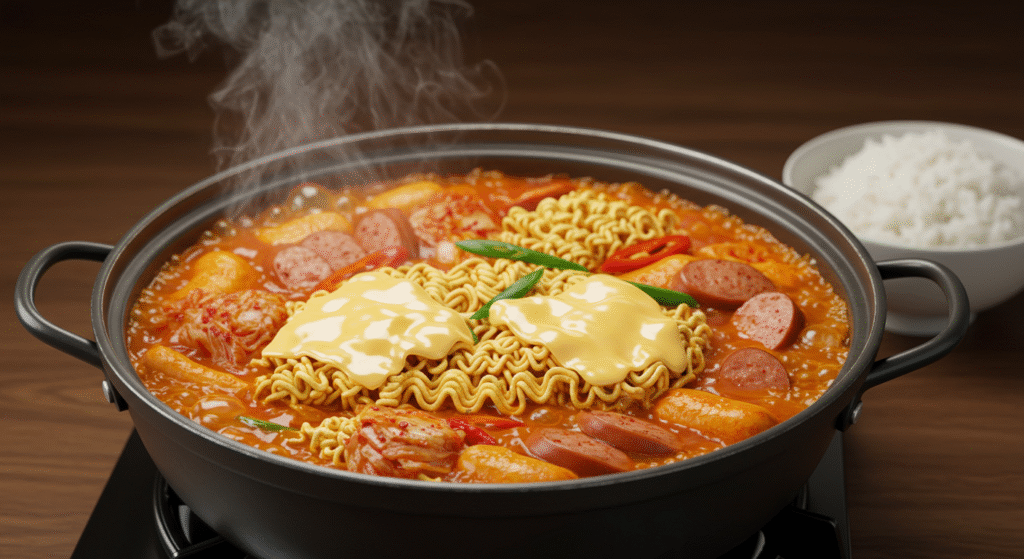
History: A dish born from the Korean War, using U.S. military base ingredients.
Characteristics: A Korean fusion stew with a spicy broth, ham, sausages, kimchi, ramen, and various ingredients.
Charm:
Easy to make with readily available ingredients, a perfect blend of spicy, savory, and rich flavors.
Tip: Ramen noodles and cheese are a must! Aged kimchi makes it even more delicious.
Budae Jjigae, now you can easily make it too!
Frequently Asked Questions ❓
Q: Does Budae Jjigae always have to be spicy?
A: No! You can adjust the amount of gochugaru (chili powder) to make it less spicy, or even omit it entirely if you prefer no spice. In that case, season with soy sauce or salt. 👉 For those who dislike spicy food, trying a little tomato paste instead of gochugaru can offer a new flavor experience!
Q: What kind of ham and sausages should I use?
A: There’s no strict rule, but typically canned ham (like Spam) or Vienna sausages, and frankfurters are commonly used. Mixing different types can create a richer flavor! 👉 The taste can vary slightly depending on the type of ham and sausage, so feel free to experiment with different varieties.
Q: Can I add other ingredients besides ramen noodles?
A: Yes, of course! It’s also delicious with tteok (rice cakes), mandu (dumplings), glass noodles, or fish cakes. Personally, I love adding flat glass noodles. 👉 While ramen noodles are the most common in Korea, you can add various other ingredients according to your preference to create your own unique Budae Jjigae.
Today, we explored Budae Jjigae, a special dish that carries Korea’s painful history but is now loved worldwide. How was it? I hope you feel confident that it’s not as difficult as it seems and that you can definitely make it at home! Why not enjoy a delicious meal with your own homemade Budae Jjigae and introduce this special K-Food to your family and friends? If you have any more questions, feel free to ask in the comments! 😊
⬆️ Back to Top

